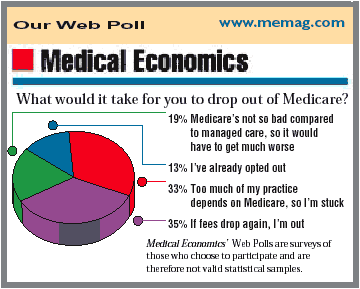Article
UPDATE: Focus on practice
Medmal crisis; starting salaries
UPDATE
Focus on Practice
By Joan R. Rose
New questions about patient care quality
American adults receive only about 55 percent of the care recommended as "quality indicators," according to a new Rand Health study. One of the problems, says lead study author Elizabeth A. McGlynn, is that most physicians don't "take advantage of the latest technology to keep track of what they have done for their patients or to share that information with other doctors and with patients themselves."
Based on reviews of medical records and interviews with nearly 7,000 adults in 12 metropolitan areas, researchers' findings were similar whether the patient was getting preventive care or being treated for a chronic or acute condition. There were variations among specific diagnoses, however. Patients with cataracts receive about 79 percent of recommended care, while those with alcohol dependence get just 11 percent.
You'll find the full report in the June 26 issue of The New England Journal of Medicine.
No more physicians' scribbles?
Doctors are notorious for poor handwriting, and one state, Florida, has done something about it. To minimize the number of misread handwritten prescriptions, Gov. Jeb Bush recently signed legislation requiring that all written prescriptions be printed or typed. In addition, the quantity of the drug prescribed must be indicated in both textual and numerical formats, and the month the script is written must be spelled out.
Research sponsored by the Agency for Healthcare Research and Quality found that adverse drug events decline when physician handwriting is not a factor. The law went into effect on July 1.
Will the medmal crisis get worse before it gets better?
A new report from the US General Accounting Office says that rapidly escalating medical malpractice insurance prices are caused primarily by insurers' losses on medical malpractice claims, rather than poor investments, as some have claimed. This backs another new study, this one by New York-based Conning Research & Consulting, that not only points to an increase in severity of claims, but holds out little hope for improvement in industry loss ratios for at least the next two years. Consequently, Conning suggests, medical malpractice coverage is likely to become even more scarce and expensive.
Most wanted doctors: Don't count yourself out
Demand for physicians is no longer centered on three or four specialties, according to Merritt, Hawkins & Associates, an Irving, TX-based recruiting firm. Although the demand for radiologists, orthopedists, cardiologists, and anesthesiologists remained strong over the past year, Merritt's recruiting assignments focused on other areas, such as pediatric subspecialties, as well. While the need for primary care physicians is less acute than for specialists, family practitioners, internists, and ob/gyns still rank among the firm's top 10 searches.
Our Web poll

Joan Rose. UPDATE: Focus on practice.
Medical Economics
Aug. 22, 2003;80:12.





